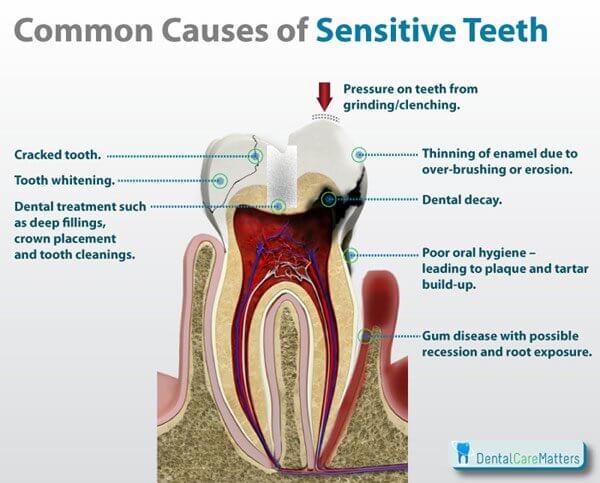If you wince when sipping a hot drink or biting into an ice cream, then chances are you suffer with tooth sensitivity. Tooth sensitivity is normally a short, sharp episode of pain following exposure of the tooth to hot, cold, sweet or acidic foods or drinks. The sensitivity is the result of exposing the dentine (the sensitive part of the tooth), which can occur following gum recession, tooth erosion, tooth decay or fracture of the tooth.

So, how do we treat sensitive teeth?
Tooth decay or a fracture of the tooth should be treated by the placement of a restoration such as a filling, inlay or crown.
Sensitivity due to recession or erosion can be managed in multiple ways:
- Acids and sugars found in foods and drinks such as fruit juice, carbonated drinks, tomatoes etc soften the tooth surface. To prevent the softened enamel being brushed away, wait at least 30 minutes before brushing your teeth, to give your saliva time to neutralise the acid.
- Reduce the number of times during the day that you have acidic foods and drinks.
- Rinse your mouth with water after eating acidic foods and drinks.
- Acids produced by dental plaque will make sensitivity worse if it is not removed. The use of the correct techniques for brushing and cleaning in between the teeth will effectively remove the plaque. Speak to our hygienist and they will be able to advise you on the right techniques.
- We may also recommend the use of an extra fluoride mouthwash as an additional preventive measure. It should be used at a different time to brushing and be rinsed around the mouth for at least 2 minutes.

- The use of desensitising toothpastes can also help to reduce sensitivity. The desensitising ingredient in the toothpaste needs to be in contact with the tooth surface for some time to be effective.
Either:
Use the desensitising toothpaste as a normal toothpaste. After brushing spit out any excess, but do not rinse
And/or:
After brushing (and at other times e.g. last thing at night) apply the desensitising toothpaste as a cream to the affected tooth/teeth. Do not rinse.
The toothpaste can take a few weeks to be effective. Use the toothpaste on a long term basis as the sensitivity may re-occur.
- If the sensitivity is isolated to a small number of teeth then a concentrated fluoride varnish can be applied by the dentist or hygienist.
- Occasionally we may place a small tooth coloured filling over the sensitive area of the tooth.
If you would like to know more about tooth sensitivity & its treatment, please ask a member of the dental team.


